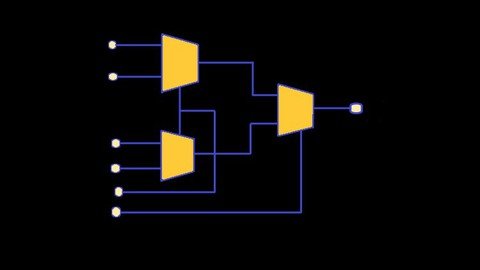 Free Download System Design Using Vhdl
Free Download System Design Using VhdlPublished 8/2023
MP4 | Video: h264, 1280x720 | Audio: AAC, 44.1 KHz
Language: English | Size: 28.61 GB | Duration: 38h 24m
FPGA Based Design
What you'll learn
Learners can understand the difference between various PLDs
Learners can understand various construct of VHDL
Learners can start writing VHDL Code for combinational digital circuits
Learners can start writing VHDL Code for sequential digital circuits
Requirements
No programming knowledge needed
Description
After completion of this course learners will be able to:(1) Understand the concepts of design metrics which are to be optimized by a design engineer(2) Understand the concepts of IC design technology(3) Understand the implementation of logic using Fixed Function IC Technology, Full Custom ASIC Technology, and Semi-Custom ASIC Technology(4) Understand the advantages and disadvantages of implementation of logic using Fixed Function IC Technology, Full Custom ASIC Technology, and Semi-Custom ASIC Technology(5) Understand the concept of implementation of logic in PLAs, PALs, and CPLDs(6) Understand the concept of implementation of logic in FPGAs(7) Understand the IC design flow(8) Understand the role of HDL in system design(9) Understand the concepts of various VHDL constructs(10) Understand various operators and their uses in VHDL coding(11) Understand how to use Xilinx software for writing a VHDL code(12) Understand how to use Xilinx software for simulating a VHDL code(13) Understand how to use Xilinx software for implementing a VHDL code(14) Implement combinational logic by using a behavioral modeling style(15) Implement combinational logic by using a dataflow modeling style(16) Implement combinational logic by using a structural modeling style(17) Implement sequential logic by using a behavioral modeling style(18) Implement sequential logic by using a structural modeling style
Overview
Section 1: IC Design Technology
Lecture 1 Introduction to course
Lecture 2 Design Metrics
Lecture 3 Fixed Function IC Technology
Lecture 4 Full Custom ASIC Technology
Lecture 5 Semi-Custom ASIC Technology
Lecture 6 HDL Role in System Design
Lecture 7 PLD Technology (PLA)
Lecture 8 PLD Technology (PAL) - I
Lecture 9 PLD Technology (PAL) - II
Lecture 10 CPLD
Lecture 11 FPGA (Architecture)
Lecture 12 FPGA (Logic Implementation Examples)
Section 2: Basic Elements of VHDL
Lecture 13 History of VHDL
Lecture 14 Introduction of VHDL
Lecture 15 Data Object - I
Lecture 16 Data Object - II
Lecture 17 Data Object - III
Lecture 18 Data Types - I
Lecture 19 Data Types - II
Lecture 20 Data Types - III
Lecture 21 Data Types - IV
Lecture 22 Data Types - V
Lecture 23 Data Types - VI
Lecture 24 Operators - I
Lecture 25 Operators - II
Lecture 26 Operators - III
Lecture 27 Operators - IV
Lecture 28 Operators - V
Lecture 29 Operators - VI
Lecture 30 Operators - VII
Lecture 31 Operators - VIII
Section 3: Behaviour Modelling
Lecture 32 Introduction to Behavior Model
Lecture 33 Behavior Model (Example)-I
Lecture 34 Behavior Model (Example)-II
Lecture 35 Testbench-I
Lecture 36 Testbench-II
Lecture 37 Behavior Model – Some concepts
Lecture 38 Behavior Model Full Adder (Alternate Code)
Lecture 39 Behavior Model (2 to 1 Multiplexer)
Lecture 40 Behavior Model (1-Bit Comparator)
Lecture 41 Behavior Model (2 to 4 Decoder)
Lecture 42 if-else statements
Lecture 43 Level Triggered D Flip Flop using if-else statement
Lecture 44 2 to 1 Multiplexer using if-else statement
Lecture 45 4 to 1 Multiplexer using if-else statement
Lecture 46 Half Adder using if-else statement
Lecture 47 Full Adder using if-else statement
Lecture 48 1-Bit Comparator using if-else statement
Lecture 49 2-Bit Comparator using if-else statement
Lecture 50 Introduction to "case" Statement
Lecture 51 2 to 1 Multiplexer using case Statement
Lecture 52 4 to 1 Multiplexer using case Statement
Lecture 53 1-Bit Comparator using case Statement
Lecture 54 2 to 4 Decoder using case Statement
Lecture 55 Half Adder using case Statement
Section 4: Dataflow Model
Lecture 56 Dataflow model of AND gate
Lecture 57 Dataflow model of Half and Full Adder
Lecture 58 Dataflow model of Full Adder (Alternate Method)
Lecture 59 Dataflow model of 2-to-4 Decoder
Lecture 60 Dataflow model of 2-to-1 Mux (using Conditional Signal Assignment Statement)
Lecture 61 Dataflow model of 4-to-1 Mux (using Conditional Signal Assignment Statement)
Lecture 62 Dataflow model of 1-Bit Comparator (using Conditional Signal Assig. Statement)
Lecture 63 Dataflow model of 2-to-1 Mux (using Select Signal Assignment Statement)
Lecture 64 Dataflow model of 4-to-1 Mux (using Select Signal Assignment Statement)
Lecture 65 Dataflow model of 1-Bit Comparator (using Select Signal Assignment Statement)
Section 5: Structural Model
Lecture 66 Introduction to Structure Model
Lecture 67 Half Adder Structure Model
Lecture 68 Full Adder Structure Model
Lecture 69 2 to 1 Multiplexer Structure Model
Lecture 70 2 to 4 Decoder Structure Model
Lecture 71 1-Bit Comparator Structure Model
Lecture 72 3-Bit Adder Structure Model
Lecture 73 4 to 1 multiplexer using 2 to 1 Multiplexer
Section 6: Sequential Circuits VHDL Modelling
Lecture 74 D Flip flop VHDL Model-I
Lecture 75 D Flip flop VHDL Model-II
Lecture 76 Jk Flip Flop VHDL Model-I
Lecture 77 Jk Flip Flop VHDL Model-II
Lecture 78 T Flip Flop VHDL Model
Lecture 79 PIPO Behavior Model
Lecture 80 PIPO Structure Model
Lecture 81 SIPO Behavior Model
Lecture 82 SIPO Structure Model
Lecture 83 SISO Structure Model
Lecture 84 SISO Behavior Model
Lecture 85 VHDL Code for Counters
Students who are interested to write and simulate VHDL codes for combinational and sequential circuits,Electronic Engineering Diploma, Under Graduate and Post Graduate students
Homepage
https://www.udemy.com/course/system-design-using-vhdl/
Buy Premium From My Links To Get Resumable Support,Max Speed & Support Me
System Design Using Vhdl Torrent Download , System Design Using VhdlWatch Free Online , System Design Using Vhdl Download Online
Comments

